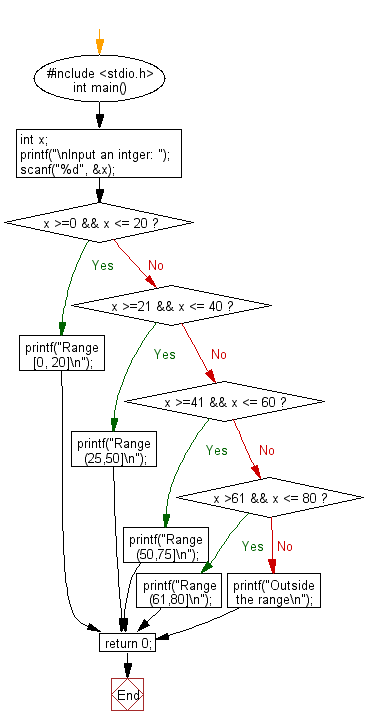Check integer range
Check integer range or error for negative > 80
Write a C program that reads an integer and checks the specified range to which it belongs. Print an error message if the number is negative and greater than 80.
Specified Range: [0, 20], [21, 40], [41, 60], [61, 80]
C Code:
#include <stdio.h>
int main() {
int x; // Declare variable to store an integer
// Prompt user for an integer and store in 'x'
printf("\nInput an integer: ");
scanf("%d", &x);
if(x >=0 && x <= 20) // Check if 'x' is in the range [0, 20]
{
printf("Range [0, 20]\n"); // Print message for the first range
}
else if(x >=21 && x <= 40) // Check if 'x' is in the range (21,40]
{
printf("Range (21,40]\n"); // Print message for the second range
}
else if(x >=41 && x <= 60) // Check if 'x' is in the range (41,60]
{
printf("Range (41,60]\n"); // Print message for the third range
}
else if(x >61 && x <= 80) // Check if 'x' is in the range (61,80]
{
printf("Range (61,80]\n"); // Print message for the fourth range
}
else
{
printf("Outside the range\n"); // Print message for values outside of all ranges
}
return 0;
}
Sample Output:
Input an integer: 15 Range [0, 20]
Flowchart:

For more Practice: Solve these Related Problems:
- Write a C program to check if an integer falls within a user-defined range and print an appropriate error message if it does not.
- Write a C program to categorize an integer into multiple intervals and display the corresponding category.
- Write a C program to repeatedly prompt the user until a valid integer within a specified range is entered.
- Write a C program to validate an integer and print a custom error message if it is negative or exceeds a given threshold.
Go to:
PREV : Solve quadratic equation using Bhaskara's formula.
NEXT : Sum all odd numbers among five inputs.
C Programming Code Editor:
Have another way to solve this solution? Contribute your code (and comments) through Disqus.
What is the difficulty level of this exercise?
Test your Programming skills with w3resource's quiz.
